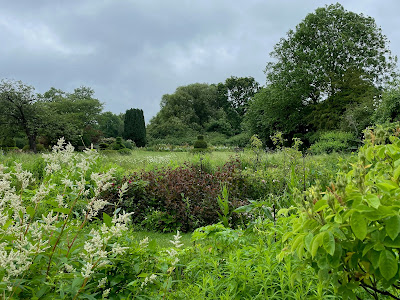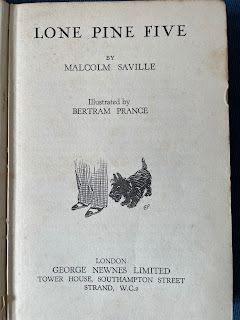A Visit to Green Knowe
It was a rainy Friday morning and we were about to drive from London to Nottingham for some birthday celebrations. The M1 is a boring road, especially in the rain, and we were trying to think of somewhere to visit on the way to break up the journey when I remembered the Manor at Hemingford Grey, Lucy Boston's house. It's not really on the way, but when I looked on the website I saw that the garden is open every day, and even if we couldn't go round the house (you have to book to do that) it would be an interesting diversion. It proved to be far more than that!
We arrived late morning in the rain, parked on the driveway and set out to explore the garden and yes, it is worth going out of the way just to see the garden. I always like visiting gardens in the rain, mainly because you usually have them pretty much to yourself, but also because I just like gardens in the rain. This one was planted almost entirely by Lucy Boston after she bought the house in the late 1930s and it seems to me that the house, the garden and the books are all part of the same act of creation. It's too simple to say that the house and garden inspired the books - it's more that the same person made them all, though of course the house had been there for hundreds of years when Lucy Boston discovered it and restored it.
There is a lovely, slightly unkempt feel to the garden and I know it takes a lot of work to keep it looking slightly unkempt rather than neglected. The topiary which features in the books is still there (it was inspired by the garden of Levens Hall that Lucy Boston knew from her youth), as is the great beech tree. There are the bamboo thickets from A Stranger at Green Knowe, and there are lots of roses. Whether Lucy Boston had as many as Frances Hodgson Burnett— who must have planted hundreds in her lifetime—that I doubt, but she did specialise in old roses, and claimed to have no rose in her garden later than 1900.
As we were walking round the garden we noticed that there were people inside the house. There were two visitors, and eventually we met them in the garden. They were incredibly enthusiastic. They'd never heard of Lucy Boston before they came, and had never read the books. They knew nothing about the history of the house and everything had been a complete surprise to them. Their tour of the house had been wonderful. It had taken two hours. We should knock on the door, they told us, and see if there was any chance we could go in.
So we did knock on the door, and Diana Boston, Lucy's daughter-in-law, who now lives in the house and runs the entire enterprise, was happy to show us around after a short and rainy lunch. I won't spoil your enjoyment by telling you everything you discover on the tour. Uniquely, in my experience, Diana Boston began by asking why we were there and how much we knew about Lucy. There is nothing worse than a house tour where the guide spends the whole time telling you things you already know and gives you no time to look at the things that really interest you. That is not the sort of tour you get at Hemingford Grey.
Some people come (from all over the world) just to look at Lucy Boston's patchwork quilts. Children (and their parents) come to see the house where the stories happened, and some come simply to see 'one of the oldest continually inhabited houses in England'. No-one is likely to go away disappointed. One of the highlights for me came when I mentioned Lucy Boston's experience (which I described in last month's post) of being presented with the Carnegie Medal. 'Have you ever seen a Carnegie Medal?' Diana Boston asked me. 'Would you like to see one?' And from a cupboard behind her she produced Lucy Boston's Carnegie Medal.
Lucy Boston said of this medal 'Mine was almost exactly like the one I got for swimming the mile when I was eleven.' All I can say is they must have had pretty grand swimming medals in those days.
I've been continuing to read Carnegie Medal winners and I'm going to fast forward through the next three from the early 1960s to take me to the point in 1966 where I feel that things began to change. 1966 was the year when Philip Turner's book, The Grange at High Force, was preferred by the judges to Alan Garner's Elidor, and with that book OUPs dominance came to an end. By 1966 they'd had 10 winners in 15 years. The Twelve and the Genii by Pauline Clarke (Faber) won in 1962. A small boy moves to a village near Haworth and finds twelve wooden soldiers in the attic. The soldiers come to life and it turns out they were once owned by Branwell Bronte and inspired much of the Bronte juvenilia - the three Bronte sisters and Branwell were the original genii. It's well written, the dialogue is convincing, the characters are good, but it feels terribly old-fashioned and middle-class. It's definitely worth a read, especially if you are a Bronte fan, but it lacks the darkness and danger of The Borrowers and maybe that's why it's largely forgotten.
The next winner was Time of Trial by Hester Burton. This is classic OUP. It's a beautifully produced book with excellent illustrations by Victor Ambrus, and a young heroine who has to stay strong when her father is imprisoned for writing and publishing a supposedly seditious pamphlet in 1801. I wish I could love it, but it's the love story that undermines the whole thing for me - she's in love with a young doctor who lodges with the family. That and the faintly ludicrous smuggling plot that's tacked on to make the story more interesting when Margaret has to move to the Suffolk coast. I just opened the book at random and my eyes fell on the last line of Chapter 2: 'Margaret shuddered with despair.'
Not a book for me.
And then there was Nordy Bank by Sheena Porter. This was a hard book to get hold of - hardback copies are expensive - so I read it in the newly re-opened British Library. It is not fun reading for 3 hours in a mask and I hope that didn't prejudice me against the book, and I didn't need to do it because I found a cheap paperback on Ebay the next day. It has the distinction of being the first winner I've read by a living author.
The action takes place in the Shropshire hills, where a bunch of children go camping. One of them, Bron, appears to become possessed by the spirit of an iron-age woman, causing her to become withdrawn and sullen. A police dog escapes from a train and roams the hills. Then somehow Bron seems to be OK again, no longer thinks the dog is a wolf, and then begins her struggle to keep the dog. None of it made much sense to me - it's about three books in one and I can't remember anything about any of the characters. I quite liked the setting, but then I thought, hold on, this is Malcolm Saville territory, so I read Lone Pine Five, which was a lot more fun and evoked the landscape far better. I would have loved it as a child. And then I came across this in Aiden Chambers's The Reluctant Reader (1969). Make of it what you will. Malcolm Saville writes:
I'll tell you a true story. Nearly 20 years ago when I was beginning to be a modest success with Lone Pine, I was approached by another editor to do another series. As I was already being copied by another popular writer, I agreed and this second series, The Jillies, is still selling well in paperback. When we got the second of these out which was a good original story I was barely mentioned although it was broadcast as a BBC Children's Hour serial. I commented on this to my editor . . . and I shall never forget his answer. 'You're too innocent and if you aren't careful you'll get hurt. You are now a success and the wolves will be after you. It will never again be the same for you. Your work will be plagiarised and even if you notice it won't be worth taking action. Your titles will be copied. Other first-time authors will use your idea of a genuine background and even the same places will be used. You will become prolific and popular and the only people who will love you are your readers and your publishers.'
Malcolm Saville, of course, never had a whiff of the Carnegie Medal. And I've started to wonder, how many of the 30 or so winners that I've read (pre-1966) have I whole-heartedly enjoyed, as in couldn't put it down? And also, how many would I have enjoyed in that way as a child? The answer is, not very many. And I'm beginning to think that the kind of book Malcolm Saville wrote deserves to be taken more notice of because, in the words of a reviewer, his books are 'workmanlike, readable and engrossing.'
Anyway, if you get the chance, pay a visit to The Manor at Hemingford Grey. You will not be disappointed.
Originally published on ABBA July 2021











Comments
Post a Comment